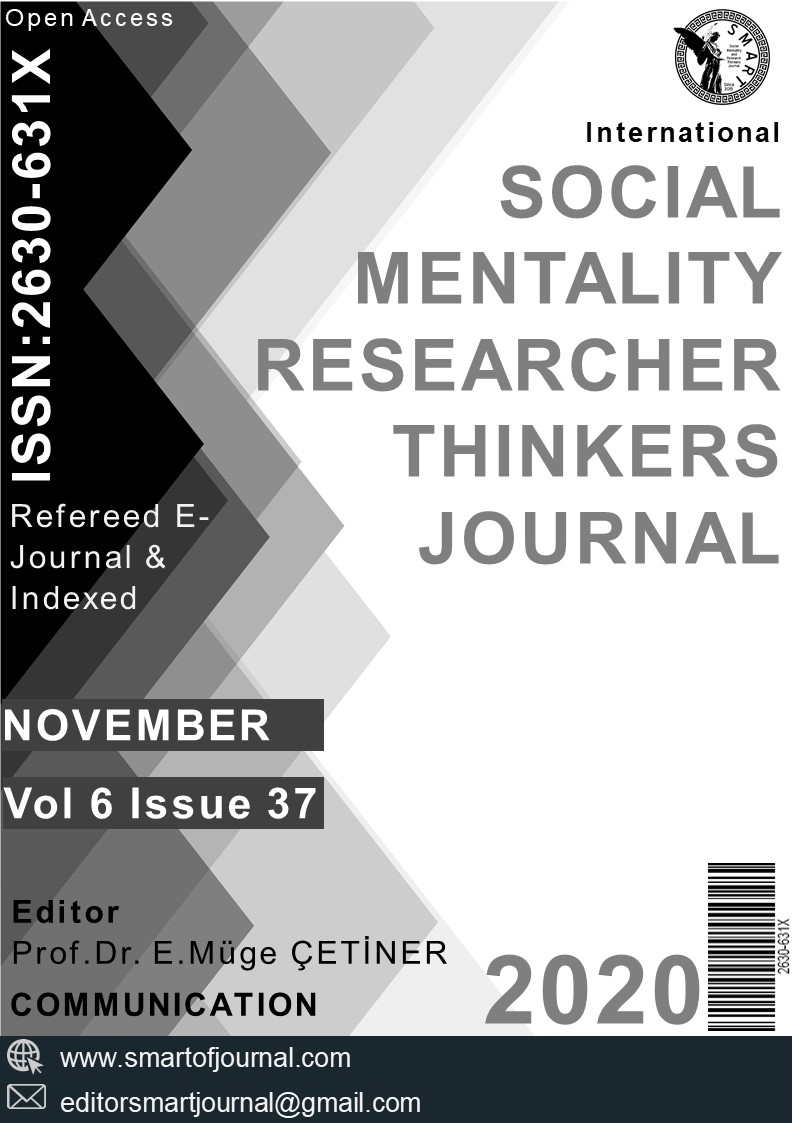ANALYSING SPORTS SUPERSTITION OF STUDENTS RECEIVING SPORTS SCIENCES EDUCATION IN TERMS OF DEMOGRAPHIC VARIABLES
Author :
Abstract
Yüzyıllar önce mit formunda varlığını gösteren batıl inançlar, bugün hala insanlar üzerinde etkisini göstermeye devam etmektedir. Bu araştırmanın amacı, spor bilimleri eğitimi alan öğrencilerin sporda batıl inançlarının demografik değişkenler açısından incelenmesidir. Bu amaçla çalışmanın evrenini, Ardahan, Atatürk, Ağrı İbrahim Çeçen, Iğdır, Recep Tayyip Erdoğan Üniversitesi spor bölümünde öğrenim gören tüm öğrenciler, örneklemini ise bu Üniversitelerde öğrenim gören ve tesadüfi yolla seçilen 1000 gönüllü öğrenci oluşturmaktadır. Bu araştırmada genel tarama modeli kullanılarak örneklem seçiminde gelişigüzel örneklem yöntemi kullanılmıştır. Araştırmada sporcuların batıl inanç davranışlarını ölçmek için Buhramn ve ark. (1982) tarafından geliştirilen ve Türkçe uyarlaması Barut (2008) tarafından yapılan 37 maddelik sporda batıl inanç ve davranış ölçeği uygulanmış olup, alınan verilerin normal dağılım gösterip göstermediğinde ise Kolmogrow Smirnow testi yapılmıştır. Sonuç olarak bu çalışmada spor bilimleri eğitimi alan öğrencilerin bölüm, cinsiyet, sportif başarı, yaş ve müsabaka öncesi yanlarında uğur getirdiğini düşündükleri nesneleri bulundurma değişkeni ile batıl inançları arasında anlamlı bir fark bulunduğu görülmüştür., Yine çalışmamıza katılan spor bilimleri eğitimi alan öğrencilerin millilik, bireysel ve takım sporcusu olup/olmama aktif spor yapılan süre değişkeni ile batıl inançları arasında anlamlı bir fark bulunmadığı görülmüştür.
Keywords
Abstract
Superstitions that existed centuries ago in the form of myths still continue to have an impact on people today. The purpose of this research, an analysing sports superstition of students receiving sports sciences education in terms of demographic variables. Within the context of this aim, all the students getting their education at the Sport departments of the universities of Ardahan, Atatürk, Agrı and Iğdır comprise the target population of the study and randomly selected 1000 voluntary students comprise sample group of the study. In this study, random sampling method was used in sample selection using general survey model. To measure the superstition behavior of athletes in the study, Buhramn et al. (1982) and the Turkish adaptation of Barut (2008), 37-item sports superstition and behavior scale was used, and the Kolmogrow Smirnow test was used when the data obtained showed normal distribution. In this study, it has been observed that there is a significant difference between the variables of students studying sport sciences department, gender, sportive success, age and possession of objects that they thought bring good luck with them before the competition and their superstitions. Again, it has been understood that there is no significant difference between the duration of active sports, being national athlete, being a player of an individual and a team athlete and their superstitions of the students who participated in our study, who are stduying in sports sciences.
Keywords
- Aghayeva, A. (2019). Batıl inançların tüketicilerin satın alma kararına etkisi üzerine bir araştırma
- Aghayeva, A. (2019). Batıl inançların tüketicilerin satın alma kararına etkisi üzerine bir araştırma(Azerbaycan ve Türkiye örneği). Yüksek Lisans Tezi. Sosyal Bilimler Enstitüsü Uluslararası Ticaret Anabilim Dalı. Gazi Üniversitesi.
- Akova, S. (2011). Batıl inançlar ve metaforlarının reklam disipliniyle ilişkisi. Filiz Otay Demir(Der.), mistik pazarlama: efsaneler, batıl inançlar ve spiritüelliğin pazarlama iletişimindeki rolü: 119-152. MediaCat Yayınları. . İstanbul
- Ayten, A., Köse, A. (2012). Din psikolojisi. İstanbul: Timaş Yayınları.
- Barut, Aİ. (2008). Sporda batıl davranış ve öz-yeterlik ilişkisi. Yayınlanmamış Yüksek Lisans Tezi, M. Ü. Sağlık Bilimleri Enstitüsü. Mersin.
- Bleak, J.L., Frederick, CM. (1998). Superstitious behavior in sport: Levels of effectiveness and determinants of use in three collegiate sports. Journal of Sport Behavior, 21(1), 1–15.
- Buhrmann, H., Brown, B., Zaugg, M. (1982). Superstitious Beliefs and Behavior: A Comparison of Male and Female Basketball Players, Journal of Sport Behavior, Vol 5(4), Dec, pp.175-185.
- Çakmak, Rf. (2019). Profesyonel futbolcuların antrenman, müsabaka öncesi veya sırasındakiinanç, batıl inanç ve farklı davranış eğilimlerinin incelenmesi. Yüksek Lisans Tezi. AfyonKocatepe Üniversitesi, Sağlık Bilimleri Enstitüsü, Beden Eğitimi ve Spor Anabilim Dalı. Afyon.Dawson, B. Trapp RG. (2001) Probability&related topics for making inferences about data.Basic&Clinical Biostatistics. 3rd Edition, Lange medical Books/McGraw-Hill Medical Publishing Division, , 69-72.
- Galeano, EH. (1997). Gölgede ve Güneste Futbol. Çev: Önalp E, Kutlu,N. İstanbul, Can yayınları. Karasar, N. (2006). Bilimsel Araştırma Yöntemi. Ankara: Nobel yayın Dağıtım,
- Kavi, O. (2019). İstanbul ili Anadolu yakası futbol kulüplerinde oynayan profesyonel futbolcuların;takıntı, batıl inanç ve düşünce kontrollerinin incelenmesi. Yüksek Lisans Tezi, Kocaeli Üniversitesi, Sağlık Bilimleri Enstitüsü, Beden Eğitimi ve Spor Anabilim Dalı.
- Kurudirek, Mİ. (2018). Buz Hokeyi Oyuncularında Batıl İnanç ve Kaygı İlişkisinin İncelenmesi. Doktora Tezi. Atatürk Üniversitesi, Kış ve Spor Bilimleri Enstitüsü, Erzurum.
- Martin, DB. (2004).Inventing superstition: from the hippocratics to the christians. The United States of America: Harvard University Press.
- Murathan, T., Murathan, F. (2019). Spor sektöründe blok zinciri uygulamaları. Gaziantep Üniversitesi Spor Bilimleri Dergisi, 4(1), 64-74.
- Neil, G., Anderson, B., Sheppard, W. (1981). Superstitious among male and female athletes of various levels of involvement. Journal of Sport Behavior, 4, 137-148 .
- Odabaşı, Y. (2016). Seçme yazılarım. Mediacat Yayıncılık. İstanbul.
- Rudski, J. (2003) “What does a “superstitious” person believe? ımpressions of participants”, The Journal of General Psychology, 130 (4), 431-432.
- Saenko, IV. (2005). “The superstitions of today’s college students”, Russian Education and Society, 47 (12), , ss. 77-8.
- Tabachnick. BG., Fidell, LS. (2013).Using multivariate statistic. Boston. Pearson
- Todd, M., Brown, C. (2003). Characteristics associated with superstitious behavior ın track and field athletes: are there ncaa divisional level differences. Journal of Sport Behavior, 26: 168,
- Url 1. (2020). https://www.bbc.com/turkce/spor-37032584. Date of acces: 21.06.2020.
- sasirtiyor_sto4257764/story.shtml. Date of acces: 21.06.2020.
- Url3. (2020). https://skor.sozcu.com.tr/2019/09/19/uc-harekete-ismini-veren-milli-jimnastikci- ferhat-arican-4uncu-yolda-1379538/. Date of acces: 21.06.2020.
- Womack M. (1992). Why athletes need ritual: A study of magic among professional athletes. In:Shirl Hoffman. Ed. Sport and Religion, Champaign, IL: Human Kinetics, ; 191-202,
- Yazıcı AN, Kalkavan A, Özdilek Ç. (2016). Üniversite öğrencilerinin beden eğitimi ve sporöğretimi dersine ilişkin tutumlarının bazı değişkenler açısından incelenmesi. International Journal of Science Culture and Sport (IntJSCS), 4:(SI 2): 404-411.





